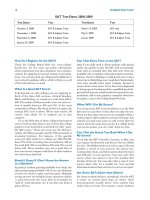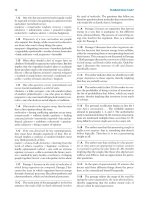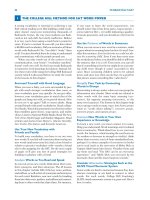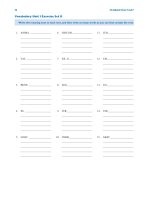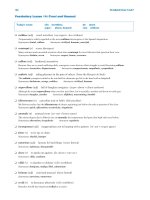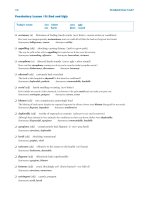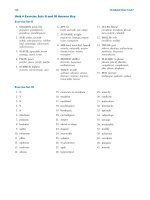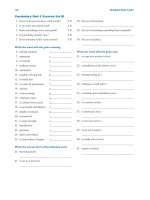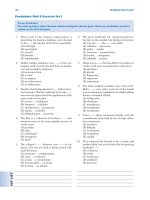Sat - MC Grawhill part 60 docx
Bạn đang xem bản rút gọn của tài liệu. Xem và tải ngay bản đầy đủ của tài liệu tại đây (269.18 KB, 10 trang )
580 MCGRAW-HILL’S SAT
1 A B C D E
2 A B C D E
3 A B C D E
4 A B C D E
5 A B C D E
6 A B C D E
7 A B C D E
8 A B C D E
9 A B C D E
10 A B C D E
11 A B C D E
12 A B C D E
13 A B C D E
14 A B C D E
15 A B C D E
16 A B C D E
17 A B C D E
18 A B C D E
19 A B C D E
20 A B C D E
21 A B C D E
22 A B C D E
23 A B C D E
24 A B C D E
25 A B C D E
26 A B C D E
27 A B C D E
28 A B C D E
29 A B C D E
30 A B C D E
31 A B C D E
32 A B C D E
33 A B C D E
34 A B C D E
35 A B C D E
36 A B C D E
37 A B C D E
38 A B C D E
39 A B C D E
40 A B C D E
SECTION
8
Start with number 1 for each new section. If a section has fewer questions than answer spaces,
leave the extra answer spaces blank. Be sure to erase any errors or stray marks completely.
1 A B C D E
2 A B C D E
3 A B C D E
4 A B C D E
5 A B C D E
6 A B C D E
7 A B C D E
8 A B C D E
9 A B C D E
10 A B C D E
11 A B C D E
12 A B C D E
13 A B C D E
14 A B C D E
15 A B C D E
16 A B C D E
17 A B C D E
18 A B C D E
19 A B C D E
20 A B C D E
21 A B C D E
22 A B C D E
23 A B C D E
24 A B C D E
25 A B C D E
26 A B C D E
27 A B C D E
28 A B C D E
29 A B C D E
30 A B C D E
31 A B C D E
32 A B C D E
33 A B C D E
34 A B C D E
35 A B C D E
36 A B C D E
37 A B C D E
38 A B C D E
39 A B C D E
40 A B C D E
SECTION
9
Practice makes perfect—for more opportunities to take full-length SAT practice tests, visit our Online Practice Plus, on the
Web at www.MHPracticePlus/SATpractice.
CHAPTER 16 / PRACTICE TEST I 581
1 ESSAY ESSAY 1
ESSAY
Time—25 minutes
Write your essay on separate sheets of standard lined paper.
The essay gives you an opportunity to show how effectively you can develop and express ideas. You
should therefore take care to develop your point of view, present your ideas logically and clearly, and use
language precisely.
Your essay must be written on the lines provided on your answer sheet—you will receive no other paper
on which to write. You will have enough space if you write on every line, avoid wide margins, and keep
your handwriting to a reasonable size. Remember that people who are not familiar with your handwrit-
ing will read what you write. Try to write or print so that what you are writing is legible to those readers.
Important reminders:
• A pencil is required for the essay. An essay written in ink will receive a score of zero.
• Do not write your essay in your test book. You will receive credit only for what you write on your
answer sheet.
• An off-topic essay will receive a score of zero.
You have twenty-five minutes to write an essay on the topic assigned below.
Think carefully about the issue presented in the following excerpt and the assignment below.
An entertainment-driven culture runs the risk of encouraging passivity among its citi-
zens. If they can experience something vicariously through a movie, television show, or
video game, why should they get involved with the activity itself? It’s safer, after all, to watch
someone scale a mountain than to do it yourself. The effect of this passivity, of course, is
an apathetic frame of mind. We cease to care deeply about so many things because they are
experienced, at best, second-hand.
Assignment: Is apathy a problem in today’s society? Write an essay in which you answer this ques-
tion and discuss your point of view on this issue. Support your position logically with
examples from literature, the arts, history, politics, science and technology, current events,
or your experience or observation.
If you finish before time is called, you may check your work on this section only.
Do not turn to any other section in the test.
582 MCGRAW-HILL’S SAT
1. If x = 3 and 5x = 3x + y, then y =
(A) 1.5
(B) 2
(C) 3
(D) 4
(E) 6
GO ON TO THE NEXT PAGE
2 2 222 2
SECTION 2
Time—25 minutes
20 questions
Turn to Section 2 of your answer sheet to answer the questions in this section.
Directions: For this section, solve each problem and decide which is the best of the choices given. Fill in
the corresponding circle on the answer sheet. You may use any available space for scratchwork.
1. The use of a calculator is permitted.
2. All numbers used are real numbers.
3. Figures that accompany problems in this test are intended to provide information useful in solv-
ing the problems. They are drawn as accurately as possible EXCEPT when it is stated in a spe-
cific problem that the figure is not drawn to scale. All figures lie in a plane unless otherwise
indicated.
4. Unless otherwise specified, the domain of any function f is assumed to be the set of all real num-
bers x for which f(x) is a real number.
The number of degrees of arc in a circle is 360.
The sum of the measures in degrees of the angles of a triangle is 180.
Notes
Reference Information
r
A = πr
2
C=2πr
ᐉ
w
A =
ᐉw V = ᐉwh V = πr
2
h
Special right triangles
c
2
= a
2
+ b
2
A =
1
/
2
bh
h
b
ᐉ
w
h
r
h
b
c
a
2x
x
x
s
s
s
3
2
30°
60°
45°
45°
2. A store sells a package of 6 batteries for $4 and
a package of 24 of the same batteries for $12.
If you need to buy 48 of these batteries, how
much money will you save by buying them in
packages of 24 rather than packages of 6?
(A) $4
(B) $8
(C) $12
(D) $16
(E) $20
CHAPTER 16 / PRACTICE TEST I 583
2 2 222 2
3. Which of the following points does NOT lie in
the shaded region above?
(A) (1, 1)
(B) (1, 4)
(C) (2, 3)
(D) (4, 1)
(E) (5, 5)
4. If of 2x is 5, what is of 4x?
(A) 5
(B) 10
(C) 15
(D) 20
(E) 25
5. If n is a positive integer that is divisible by 12
and 16, then n must also be divisible by
(A) 28
(B) 32
(C) 48
(D) 96
(E) 192
2
3
1
3
O
x
y
6
6
GO ON TO THE NEXT PAGE
Note: Figure not drawn to scale.
6. In the figure above, if a − b = 10, then a =
(A) 60
(B) 65
(C) 70
(D) 75
(E) 80
7. If n is an integer, which of the following must
be an even integer?
(A)
(B) n + 2
(C) 2n + 1
(D) n
2
(E) n
2
+ n
8. Mike sold a total of 48 sodas at a snack stand.
The stand sells only cola and root beer. If he
sold twice as many colas as root beers, how
many root beers did he sell?
(A) 32
(B) 24
(C) 18
(D) 16
(E) 8
9. If m and n are both squares of integers, which of
the following is NOT necessarily the square of
an integer?
(A) 9m
(B) mn
(C) m
2
(D) 9mn
(E) 9m − 9n
n
2
a°
b°
40°
584 MCGRAW-HILL’S SAT
2 2 222 2
GO ON TO THE NEXT PAGE
13. If a, b, and c are positive even integers such
that a < b < c and a + b + c = 60, then the greatest
possible value of c is
(A) 36
(B) 40
(C) 42
(D) 54
(E) 57
14. The population of Bumpton increased by 10%
from 1980 to 1990 and decreased by 10% from
1990 to 2000. What is the net percent change
in the population of Bumpton from 1980 to
2000?
(A) −9%
(B) −1%
(C) +0%
(D) +1%
(E) +9%
10. If a + b = 9, a − c = 14, and a = 10, then c − b =
(A) −5
(B) −3
(C) 3
(D) 5
(E) 23
11. If the average (arithmetic mean) of a, b, 4, and
10 is 8, what is the value of a + b?
(A) 4
(B) 6
(C) 9
(D) 15
(E) 18
12. With the exception of the shaded squares, every
square in the figure above contains the sum of
the number in the square directly above it and
the number in the square directly to its left. For
example, the number 4 in the unshaded square
above is the sum of the 2 in the square above it
and the 2 in the square directly to its left. What
is the value of x?
(A) 6
(B) 7
(C) 8
(D) 15
(E) 30
12345
0
1
2
3
4
5
2
4
x
15. Several values of the function f are shown above.
The function g is defined by g(x) = 2f(x) − 1. What
is the value of g(3)?
(A) −21
(B) −13
(C) 3
(D) 11
(E) 21
x
–2
–1
0
1
2
3
4
–29
–21
–13
–5
3
11
19
f (x)
CHAPTER 16 / PRACTICE TEST I 585
2 2 222 2
16. If x > 0 and x = 5y, then
(A) 2y
(B)
(C) 4y
(D) 16y
(E) 24y
17. If x > x
2
, which of the following must be true?
I. x < 1
II. x > 0
III. x
2
> 1
(A) I only
(B) II only
(C) I and II only
(D) I and III only
(E) I, II, and III
18. Which of the following represents the distance
from the midpoint of AB
––
to the midpoint of BC
––
on the number line above?
(A)
(B) 2x − 1
(C) 2x + 3
(D) 3x + 1
(E) 4x
32
2
x +
0
x
3x+2–x – 4
ABC
y 6
xxyy
22
2−+=
19. P is the center of the circle above and
PQ = QR. If ΔPQR has an area of , what is
the area of the shaded region?
(A) 36π−
(B)
(C)
(D)
(E)
20. In a class of 160 seniors, the ratio of boys to
girls is 3 to 5. In the junior class, the ratio of
boys to girls is 3 to 2. When the two classes are
combined, the ratio of boys to girls is 1 to 1.
How many students are in the junior class?
(A) 400
(B) 360
(C) 200
(D) 180
(E) 160
693
π
−
993
π
−
18 9 3
π
−
24 9 3
π
−
93
93
Q
R
P
STOP
If you finish before time is called, you may
check your work on this section only. Do not
turn to any other section of the test.
586 MCGRAW-HILL’S SAT
3 3 333 3
1. Julia feared that her 6-month hiatus from
playing the piano would cause her musical
skills to
(A) atrophy
(B) align
(C) develop
(D) reconcile
(E) disseminate
2. Senator Harris is widely viewed as a
orator; his speeches are full of commen-
tary and domineering opinions.
(A) vindictive . . pedantic
(B) conciliatory . . treacherous
(C) didactic . . moralizing
(D) dogmatic . . meek
(E) simplistic . . prosaic
3. Walter’s was beginning to annoy his co-
workers; although they appreciated the thought
he gave to his decisions, his inability to make
up his mind was growing tiresome.
(A) vacillation
(B) solicitation
(C) rejuvenation
(D) admonishment
(E) professionalism
4. To succeed as a writer, one needs a great deal
of ; successful writers are even in
the face of countless rejections.
(A) affluence . . haughty
(B) pertinacity . . apologetic
(C) intimidation . . resilient
(D) tenacity . . relentless
(E) stoutness . . craven
GO ON TO THE NEXT PAGE
SECTION 3
Time—25 minutes
24 questions
Turn to Section 3 of your answer sheet to answer the questions in this section.
Directions: For each question in this section, select the best answer from among the choices given and
fill in the corresponding circle on the answer sheet.
Each sentence below has one or two blanks,
each blank indicating that something has been
omitted. Beneath the sentence are five words
or sets of words labeled A through E. Choose
the word or set of words that, when inserted
in the sentence, best
fits the meaning of the
sentence as a whole.
EXAMPLE:
Rather than accepting the theory unquestion-
ingly, Deborah regarded it with
.
(A) mirth
(B) sadness
(C) responsibility
(D) ignorance
(E) skepticism
A
C D
E
B
CHAPTER 16 / PRACTICE TEST I 587
3 3 333 3
5. Although direct, forceful stances usually ap-
peal to voters on the campaign trail, candidates
usually resort to during debates to avoid
alienating any potential supporters.
(A) pontification
(B) circumlocution
(C) logic
(D) exaggeration
(E) brevity
6. Counselors in the prison rehabilitation pro-
gram must have faith in the of those who
have committed felonies, yet be wary of ;
they must believe that criminals can change,
but know that they can often return to their
old habits.
(A) mutability . . astuteness
(B) variability . . consistency
(C) coarseness . . responsibility
(D) persuasion . . transcendence
(E) malleability . . relapse
7. Marullus’ reference to “chimney-tops” during
his monologue in Julius Caesar is considered
by some historians , since such things are
unlikely to have existed in Rome in the first
century
B.C.
(A) a miscalculation
(B) an anachronism
(C) an idiom
(D) an interlocutor
(E) a mirage
8. The letter “h” at the end of Pittsburgh is of
American sentiments soon after World War I;
it was added as part of a movement during
that time to make the names of American
cities sound less German.
(A) an inference
(B) an analogy
(C) a vestige
(D) an anomaly
(E) a quandary
Questions 9–10 are based on the following passage.
Although countries can construct redoubtable
stone barriers to separate “us” from “others,”
no barrier is stronger than language. We infer
volumes from the language of another,
whether he is erudite or philistine, whether
she is noble or mean. Our labels, too, can be
impenetrable walls: we are “freedom fighters,”
they are “terrorists”; we are the “faithful,” they
are the “infidels.” Those people who use such
wall-language are the Manichaeans,
1
those
who refuse to see, or cannot see, shades of
gray, the subtle truths of humanity. Their
“truths” are the most dangerous weapons,
wielded by the blind and the ignorant.
9. In this paragraph, language is characterized
primarily as
(A) biased
(B) enlightening
(C) difficult to understand
(D) unifying
(E) changeable
10. In line 4, the word “volumes” most nearly
means
(A) spaces
(B) editions
(C) measurements
(D) an abundance
(E) capacities
GO ON TO THE NEXT PAGE
The passages below are followed by questions
based on their content. Answer the questions
on the basis of what is stated
or implied in the
passage and in any introductory material that
may be provided.
Line
5
10
1
Those who believe in absolute good and evil
588 MCGRAW-HILL’S SAT
3 3 333 3
GO ON TO THE NEXT PAGE
Questions 11 and 12 are based on the following passage.
It may be difficult for adults to learn not to in-
terfere but rather to support the child’s desire
for freedom and autonomy. For example, if
you watch a boy of three trying to tie his
shoes, you may see him work with extraordi-
nary motivation even though the loops aren’t
matched, and well over half the time as he
tries for the final knot, he ends up with two
separate laces, one in each hand. Then watch
his parents as they watch their children at-
tempt a task like this. Too often the parent
will step in and take over, tie the shoes the
“right way” and defeat the child’s growing
attempt at self-mastery. The same goes for
putting on boots, coats, and even playing with
toys. It is exceedingly easy to fall into the trap
of almost always responding negatively to a
child at this age. Commonly, a parent might
say no up to 200 times a day at this stage.
Such nagging not only is aversive in the
extreme, but also a constant reminder to the
child of his or her lack of self-control.
11. The passage suggests that helping a boy to tie
his shoes the “right way” (line 13) can be
(A) necessary to his self-esteem
(B) important to his personal hygiene
(C) appropriate only if the boy has the neces-
sary fine motor skills
(D) essential to teaching him patience
(E) harmful to his autonomous development
12. The passage indicates that negative responses to
a child can lead to the child’s
(A) rebellion
(B) feeling of helplessness
(C) persistence in the task
(D) mimicking of the negative behavior
(E) anger
Questions 13–18 are based on the following passage.
The following is an essay about T. S. Eliot, an
American poet of the early 20th century, and the
Modernist movement, of which he was a part.
Modernism is the most peculiar of all artistic
movements of the twentieth century and the
most difficult to pin down since people started
coming up with “movements” in the first
place. Modernism is the only thing that strikes
more fear into the heart of an English under-
graduate than the idea of going to a lecture.
Critics and academics, not unwisely, prefer
their artistic movements to be readily compre-
hensible and clearly enough defined to make
some logical sense. Modernism, however, will
not be tamed. It is straggly, begins nowhere
and with no one in particular, and ends only
when its writers have started to baffle even
themselves. One treads carefully through its
key texts: James Joyce’s Ulysses, T. S. Eliot’s
The Waste Land (both 1922), and Virginia
Woolf’s Mrs. Dalloway (1925). The authors of
these aberrations, these posturing, egotistical,
lunatic, kaleidoscopic works of blatant and
self-conscious genius, have laid literary land-
mines throughout their works. Joyce said of
Ulysses that “I’ve put in so many enigmas and
puzzles that it will keep the professors busy
for centuries arguing over what I meant, and
that’s the only way of insuring one’s immortal-
ity.” This statement sums up the enigma of
modernism (if one can be said to sum up an
enigma) in that it contains arrogance min-
gling with modesty, cleverness tied up in self-
effacing humour, and above all absurdity with
a purpose. Plots, such as they exist at all in
modernist writing, are submerged beneath
wave upon wave of classical allusions,
archaisms, neologisms, foreign languages,
quotations, swear words and other hyper-
literary and meta-literary indulgences. If I
haven’t made it clear already, it is hard not to
love modernism. It is hard to work out what
exactly it is.
Line
5
10
15
20
Line
5
10
15
20
25
30
35
40
Second passage:
Educational Psychology: A Developmental
Approach,
Norman A. Sprinthall et al., McGraw-Hill, 1994, p. 149
CHAPTER 16 / PRACTICE TEST I 589
3 3 333 3
GO ON TO THE NEXT PAGE
14. The passage suggests that critics and acade-
mics dislike artistic movements that are
(A) enigmatic
(B) comprehensible
(C) wide-ranging
(D) inventive
(E) socially conscious
15. The “landmines” in lines 21–22 are
(A) episodes in novels that refer to violence
(B) criticisms of the works of other
novelists
(C) new methods of analyzing literature
(D) literary devices intended to baffle
academics
(E) limitations that publishers place on an
author’s work
16. The reference to “wave upon wave” (line 34)
suggests that, in Modernist fiction, plot is
(A) a powerfully moving element
(B) secondary to other considerations
(C) dominant over diction
(D) characterized by redundancy
(E) dangerous
17. The author’s overall attitude toward Modernism
can best be described as
(A) ambivalent
(B) reverential
(C) cynical
(D) indignant
(E) jocular
18. The final sentence of the passage employs each
of the following EXCEPT
(A) simile
(B) juxtaposition
(C) personification
(D) contrast
(E) metaphor
Recently, while browsing in an Oxford
bookshop, a friend of mine picked up a copy
of Finnegans Wake—James Joyce’s final
book—and read the first page. Between tears
of laughter, he managed to indicate to me
that he couldn’t understand a word of it. It is
hard not to sympathise with the outsider’s at-
titude so amply demonstrated by my friend’s
outburst of shock and wonder. To find one of
our most famous authors writing gibberish is
rather heartening. Yet we remain outsiders
to the work. Finnegans Wake, you see, is em-
blematic of all that is right and wrong with
modernism. It took a spectacularly long time
to write and was finally published in 1939,
seventeen years after its predecessor, Ulysses.
That probably had something to do with the
fact that over 40 different languages crept
into its catalogue of portmanteau words
(ersatz words consisting of two or more real
words or word elements, like those of Lewis
Carroll in his poem “Jabberwocky”). The re-
sulting book is uniquely inventive and at the
same time uniquely confusing. In that sense,
it is the perfect example of a modernist text.
It alienates its readers just as it tries to
mimic how they think. The English mod-
ernist novel is a sociopath and a cad: danger-
ous and reprehensive but somehow roguishly
likeable.
13. In the first paragraph, the author character-
izes Modernism as which of the following?
I. self-centered
II. ill-defined
III. politically oriented
(A) I only
(B) II only
(C) I and II only
(D) II and III only
(E) I, II, and III
45
50
55
60
65
70
Excerpted from
T. S. Eliot and the Elitism of Modernism,
by
David Pinching, on
